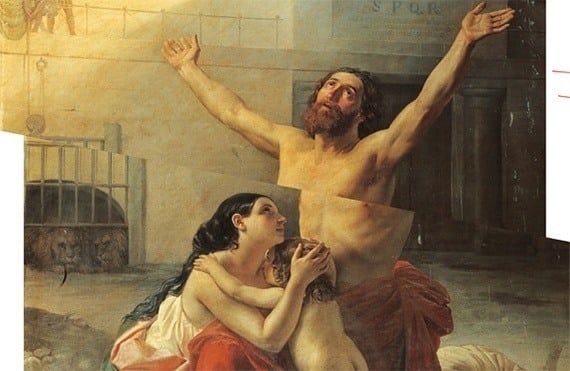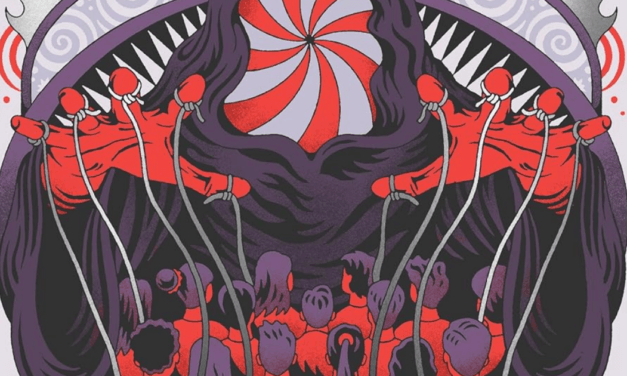This article first appeared in the CHRISTIAN RESEARCH JOURNAL, volume 36, number 06 (2013). The full text of this article in PDF format can be obtained by clicking here. For further information or to subscribe to the CHRISTIAN RESEARCH JOURNAL go to: http://www.equip.org/christian-research-journal/
The title of this book will outrage anyone who has even a rudimentary knowledge of Christian history, since the most indisputable fact from the church’s past is that Christians were indeed tortured and martyred in the early years of the faith. To question this is to share in the crude folly of Holocaust-deniers today. Both the publisher and author are banking on this reaction to sell this title.
The book itself, however, is much less provocative than its title suggests, so we have something of a bait and switch tactic to corral readers.
Candida Moss is professor of New Testament and early Christianity at Notre Dame. In this book, her basic thesis is that the standard traditions of the long, bloody persecutions of Christians by a hostile Roman Empire and the heroic martyrdoms of the faithful have been exaggerated, even invented, by the church and its historians—especially Eusebius of Caesarea, the “father of church history.” This was done for hagiographic purposes, Moss claims, to provide models for emulation by the faithful. But a close reading of the sources, she contends, shows that the persecutions were not continual but sporadic, not always inaugurated by the emperor in charge, and limited in scope, area, and duration. Later hagiographers in the church, however, augmented these facts by introducing many more victims martyred with greater cruelties in persecution. In fact, a later group in the church called the Bollandists was organized to moderate these excessive reports.
So far, so good. This reviewer, in fact, can concur with these conclusions. If Moss’s research serves to help dispel old images of uninterrupted Roman persecution from Nero to Constantine by always-hostile emperors victimizing heroic Christians who always gave their lives for Christ and should serve as models today for how to practice the faith, then fine. The image is wrong and should be dispelled. One wonders, though, how many really have such a caricatured image.
Unfortunately the intentionally controversial title and subtitle of Moss’s study continue in some of her chapter headings, such as “Christian Borrowing of Jewish and Pagan Martyrdom Traditions” and “Inventing Martyrs in Early Christianity.” Such chapters come out less provocative, however, than their ire-inciting headers would
suggest. Moreover, lest anyone call for Moss’s dismissal from the faculty at Notre Dame, such statements as the following should not be overlooked despite their extremely rare inclusion and obvious minority status in her approach: “There is no doubt that Christians did die, that they were horrifically tormented and executed in ways that would appall people today, however uninterested they are in human rights” (p. 160). Thirty-three pages of highly relevant notes and a very detailed index further enhance these pages.
This is not, however, to suggest that the book is fine except for its specious titling. Quite on the contrary: in mounting a bristling defense for her less-than-tenable thesis, Moss plainly overdid it. While her research is thorough, her conclusions are much too arbitrary and biased for serious scholarship. The basic problem is that what is true in this book is not new, and what is new in this book is mostly not true.
TRUE, BUT NOT NEW
Admittedly it may be a somewhat common impression that the early persecutions were one long horror story from Nero on until Constantine, the first Christian emperor, halted them two and a half centuries later. All scholars of early Christianity regard this view as mistaken, yet in countering it, Moss attacks a straw man. Did the early Christians really “invent” this image, as the book’s subtitle claims? Hardly! Eusebius of Caesarea clearly reports on those long periods in Roman history when the early church was at peace and not harassed by the Roman government—a fact well known to all who have learned even a bit of church history. To help broaden that understanding, The Myth of Persecution may perhaps be helpful.
Moreover, the fact that some Roman emperors did not inaugurate persecutions, which were sparked instead by local initiative—especially by pagan priests—is likewise well known and detailed by Eusebius. Similarly the impression that all Christian victims heroically kept the faith in the face of torment and death is also false. Again, however, Eusebius provides detailed information on those who abandoned the faith under such pressure. Human nature has not really changed over the last two millennia. But one doubts that this comes as fresh information to any readers today.
In defending her thesis, Moss resorts to several rhetorical devices that would have gladdened the heart of a Greek Sophist. The convenient use of the straw man has been mentioned. Another is the use of modifying adjectives and adverbs that enable Moss to escape outright falsehood while misleading casual or careless readers.
Note, for example, the use of constantly in this sentence: “The traditional history of Christian martyrdom is mistaken: Christians were not constantly persecuted, hunted, or targeted by the Romans” (14). Only much-later hagiographic literature and perhaps current bad teaching claim that the persecutions were continual.
Similarly Moss tries to minimize Rome’s role in persecution by noting that some of the victims were prosecuted, not persecuted, and that some emperors did not inaugurate the persecutions that happened on their watch. True enough, but the effect is to mislead the reader into doubting the entire persecution package. But persecution is persecution. Martyrs are martyrs.
NEW BUT NOT TRUE
In her apparent enthusiasm to support a provocative and even “sensational” thesis, Moss skirts the extreme edge of accurate history and sometimes falls off entirely. One example alone shows how cavalier and negatively biased her methodology can be. The moment I heard about the book with this intentionally aggravating title and subtitle, I immediately muttered derisively, “Right! And what about Tacitus?”
Perhaps the most important source that tears the intended impact of this book’s title into shreds is Cornelius Tacitus’s Annals 15:44. A pagan Roman historian who deemed the Christians little more than sewage, Tacitus writes the following about Nero’s persecution:
First the confessed members of this sect [i.e., Christians] were arrested. Next, on their disclosures, vast numbers were convicted, not so much on the charge of arson as for hatred of the human race. And derision accompanied their end: they were covered with wild beast’s skins and torn to death by dogs; or they were fastened on crosses and, when daylight failed, were burned to serve as lamps by night. Nero had offered his Gardens for the spectacle, and gave an exhibition in his hippodrome, mixing with the crowd in the garb of a charioteer or mounted on his chariot.
Moss does not even quote this passage verbatim, as I have done, although she does summarize it. Since this is so destructive to her main thesis, she tries, astonishingly, to reduce its credibility. First she uses the timeworn argument of time itself (always theweakest argument): Tacitus, she states, wrote “at least fifty years after the event he describes” (139). And her point is? This is the same as suggesting that no one today can write accurately about what happened in the Kennedy administration!
Her next argument to undermine the Tacitus passage is an egregious error in stating that the term “Christian” was not used until, “at the earliest, the end of the first century” (139). But Luke, the evangelist, writing in AD 62 (never mind that some scholars would put it a decade later), tells us that the followers of Jesus were first called Christians at Antioch even before Paul’s first mission journey in AD 47 (Acts 11:26). This erroneous claim is written by a professor of New Testament at a prestigious university? Do they have editors at HarperOne?
Other adduced arguments against Tacitus fail as well. That the cited text is an admission conceded by not a friendly but a hostile source only underlines its authenticity and credibility. In any case, what an unfortunate way to handle documentation that contradicts one’s thesis: do all you can to undermine it.
In seeking to correct exaggerations of Christian martyrdom, the author offers plenty of her own. In the Roman persecutions, “very few Christians died,” she writes (14), a hopelessly wrongheaded statement, directly contradicted by the Roman Tacitus himself, who reports that there were “vast numbers” in Nero’s persecution alone, as noted previously, not to mention the host of victims in the decades and centuries to follow. This error is so glaring that, in the name of truth itself, the author must withdraw or change it in future printings, or be required to do so by her publisher.
Again, “Scholars of early Christianity agree that there is very little evidence for the persecution of Christians” (18). In fact, the only such scholar I know of is Candida Moss! The evidence is instead overwhelming and categorical. Rarely do both friendly and hostile sources agree on anything, but the persecution of Christians is one of them. Aside from copious Christian evidence, not only Tacitus but also Suetonius, another pagan Roman historian, writes, “Punishments were also inflicted on the Christians, a sect professing a new and mischievous religious belief” (Nero, 16). Amazing that not a word of this appears in Moss’s book!
And again, “There are no stories about the deaths of martyrs that have not been purposely recast by later generations of Christians in order to further their own theological agenda” (17). Wrong again! Tacitus is cited intact by later writers, Christian and secular, as is the eyewitness report of the martyrdom of Polycarp, and others.
Moss claims, “Christianity adopted the martyrdom idea from non-Christians. Long before the birth of Jesus, the ancient Greeks told stories about their fallen heroes…and Romans saw the self-sacrifice of generals as a good thing, and Jews in ancient Palestine accepted death before apostasy” (17). While most of this is true, the first sentence claiming that “Christianity adopted the martyrdom idea” elsewhere is utterly false and bad logic to boot. Martyrdoms can happen independently anywhere and at anytime. They are certainly not copied or “adopted.”
And finally, in connection with the first empire-wide, systematic persecution of the church under the emperor Decius (ruled 249–251), Moss writes, “There is little to suggest that Decius had Christians in particular in mind when he issued his decree” (161). Here again the author’s extremely critical bias is evident, since historians of the ancient world—secular and Christian—have no doubt whatever that Christians were Decius’s principal target.
The author’s claim that there was no persecution of Christians between Nero’s reign and that of Decius in the mid-third century is also a new but mistaken version of the facts. It overlooks the persecution of Domitian c. AD 95 that involved members of the imperial Flavian family itself and traditionally saw John flee to Patmos to escape it; the martyrdoms of such Christian leaders as Ignatius of Antioch, Polycarp of Smyrna, and Justin Martyr; the Christian victims of Lyons; and the persecution under Emperor Septimius Severus (193–211).
BLAMING EUSEBIUS
By now the reader will have noted that Moss and Eusebius have very little in common. It might be expected, then, that she will try to undermine evidence from Eusebius. We are not disappoint ed. Moss gives Eusebius the credit or discredit for the augmentation of persecution and martyrdom in the history of the church. In fact, however, only about 9 percent of his Church History deals with these themes as he focuses instead on travels and successors of the apostles, early church government, heresies, apologists for the faith, formation of the canon, literary history, and doctrinal controversies—a reasonable balance. Eusebius’s evidence cannot be impeached, since he personally witnessed the horrors of the final Great Persecution, was imprisoned himself, and saw his behooved teacher, Pamphylus, martyred. The wonder is that Eusebius did not offer more on the persecutions than 9 percent of the whole.
Much of that material consists of eyewitness reports of persecution that were so specific and reliable that Eusebius simply incorporated the documents en masse. The evidence is overpowering that persecution of Christians and the attending martyrdom was a constant threat throughout the two and a half centuries before Constantine, even if there was not continual bloodshed. But to claim that there were only ten years of actual persecution during this period, as does Moss, is merely another in her cavalcade of mistaken conclusions that run counter to the facts.
In sum, we have a case of over-correction in this book that, in attempting to clean the historical record on persecution and martyrdom, has scrubbed away solid fact as well. Both excessive embellishment and excessive purgation do poor service to the cause of historical truth. This exercise in revisionism, then, has failed.
Each of Moss’s eight chapters ends with a helpful conclusion in which she summarizes the arguments set forth therein. A conclusion to this review would merely appeal for a more honest title and subtitle for her book, perhaps something like: The Myth of Exaggerated Persecution: How Later Christians Embellished the Record. That would have far more integrity but, of course, sell fewer books. —Paul L. Maier
Paul L. Maier is professor emeritus of ancient history at Western Michigan University and a much-published author. He has translated new editions of Josephus and Eusebius, and written the best-selling A Skeleton in God’s Closet (Thomas Nelson, 1994). His latest book is The Constantine Codex (Tyndale, 2011).









